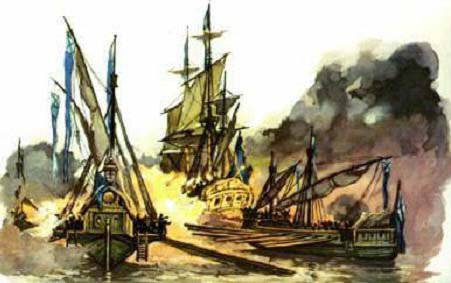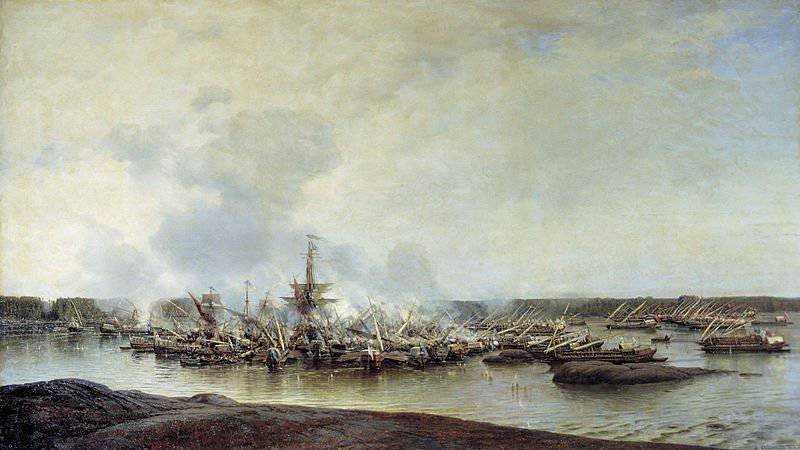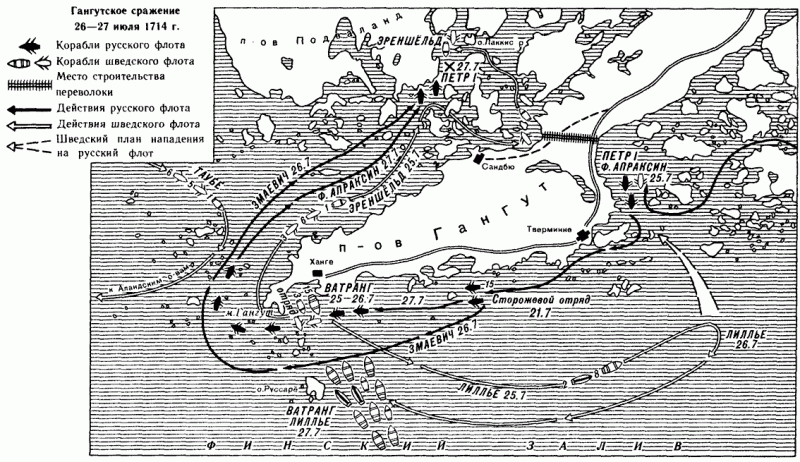Gangut sea battle - the first major victory of the Baltic Fleet
 In the campaign of 1714, large tasks faced the Russian Baltic fleet - Aland Islands were chosen as the main operational area. The plans of the Russian command for 1714 (due to unsuccessful negotiations with the Danes regarding joint actions within Sweden itself) were limited only to the final seizure of Finnish territories. A decisive attack on Karlskrona or Stockholm had to be postponed. On May 9 (20), 1714, the Russian galley fleet under the command of Fyodor Apraksin (about 100 ships with 15 thousandth landing) left St. Petersburg for Kronshlot. He was given the task to advance in cooperation with the ground forces under the command of Golitsyn. In mid-May, galleys under the cover of a ship fleet (9 battleships, 5 frigates. 3 shnyavs) moved to Helsingfors. At Vyborg the fleet was divided, the galleys continued to go to Helsingfors, and the sailing ships turned to Revel. From Helsingfors the galley fleet moved to Tverminna.
In the campaign of 1714, large tasks faced the Russian Baltic fleet - Aland Islands were chosen as the main operational area. The plans of the Russian command for 1714 (due to unsuccessful negotiations with the Danes regarding joint actions within Sweden itself) were limited only to the final seizure of Finnish territories. A decisive attack on Karlskrona or Stockholm had to be postponed. On May 9 (20), 1714, the Russian galley fleet under the command of Fyodor Apraksin (about 100 ships with 15 thousandth landing) left St. Petersburg for Kronshlot. He was given the task to advance in cooperation with the ground forces under the command of Golitsyn. In mid-May, galleys under the cover of a ship fleet (9 battleships, 5 frigates. 3 shnyavs) moved to Helsingfors. At Vyborg the fleet was divided, the galleys continued to go to Helsingfors, and the sailing ships turned to Revel. From Helsingfors the galley fleet moved to Tverminna. Further way to Abo closed the fleet under the command of Gustav Vatranga - 15 battleships, 3 frigate and a squad of rowing ships. The Swedes took a position near the southwestern part of the Gangut peninsula. June 29 Russian squadron stopped a few kilometers from the Swedish forces. For almost a month, the enemies watched each other. 30 June, 1 and 3 July Apraksin and Wade personally conducted reconnaissance from the sea, and then from Gangutsky Cape. General-Admiral Apraksin presented the king with four basic options for further action: 1) pay the Danes a considerable amount and “rent” their fleet in order to break through the Swedish forces with combined forces; 2) to make a demonstration by ship fleet at Revel in order to divert the Swedish forces and at this time penetrate to the Aland Islands; 3) bypass the Swedish ships by sea, during the calm; 4) stop the campaign. Waiting for Peter’s instructions, the admiral established close surveillance of the Swedish ships, occupied Gangutsky Cape with three battalions of the guard, erected fortifications and installed coastal batteries to prevent the Swedes from landing operations. July 10 with the forces Apraksina united infantry detachment Golitsyn.
On July 20 Peter I arrived to Tvermin from Revel. On April 21-22 he personally conducted reconnaissance. The Russian tsar decided not to risk the ship fleet and make a breakthrough only with the help of galleys. During the reconnaissance, Peter had an original idea: to arrange a curb of logs in a narrow part of the peninsula (2,5 km) and drag several light galleries through it. The detachment in the rear of the enemy was to cause embarrassment to the Swedes, to allow the main forces to break through to the Abo-Aland district. At the site, perevoloki began to build a special platform from the middle of the isthmus in both directions to the bays, the court planned to drag along logs on a special sleigh.
The Swedish command, having learned about the actions of the Russians, decided to take countermeasures. Part of the Swedish squadron under the command of Vice-Admiral Lille (8 battleships, 2 bomber ships) went to the southeast to try to attack the main Russian forces at Tverminna. The galley detachment under the command of Rear Admiral Niels Erenshilda (1 frigate, 6 galleys, XHUMX scherbot) advanced to the north-west exit. The rest of the fleet under the command of Admiral Watranga (3 of the battleships and the 7 frigate) remained at the same position. As a result, the Swedish forces were fragmented. Now it is possible to destroy one part of the Swedish forces. Peter immediately appreciated the benefits of the moment and ordered to prepare for a breakthrough.
The situation has improved even more because of the calm that has come. Swedish sailboats were immobilized. A breakthrough by Cape Gangut decided to carry out several detachments. In the vanguard, there were 20 scamps under the command of captain-commander Matvey Khristoforovich Zmayevich. The naval commander was from a noble Montenegrin family, gained extensive experience in the Venetian navy and was accepted to the Russian service in 1712. Zmajevich received an order to cross between the Vatrang and Lille squadrons. Vatrang arranged his ships in line, as close as possible to the shore. 26 July in the morning 8 Russian avant-garde went for a breakthrough. Vatrang tried to bring the ships to the point of breakthrough with the help of lifeboats, while at the same time trying to get Russian ships with the help of artillery. Zmayevich successfully passed the position of the Swedes, followed by the breakout of the Lefort guards (15 scampaway).
During the movement around the peninsula, Gangut met a Swedish detachment under the command of Taube (1 frigate, 5 galleys, 6 scherbots). Taube went to connect with the forces of Watranga. The Swedes decided that the whole Russian fleet was in front of them and turned back to the Aland Islands. At this time, the king was informed about the movement of the Swedish ships to the transfer. Peter ordered the Swedes to attack, but Erenshild declined to fight and moved to the north-west and got into the so-called. “False fairway”, followed closely by Zmaevich’s ships and blocked the Swedish squad.
At this time, Vatrang, believing that the main forces of the Russian galley fleet would repeat the breakthrough of Zmayevich’s detachment, summoned Lille and lined the ships in two lines. At the same time, he walked away from the coast, having made a new mistake - he opened the way near the coast. The Russian command did not miss this chance. July 27 in the morning 4 began the breakthrough of the main forces. The squadron was guided by three detachments: in the vanguard, General Weide, in the center of Apraksin, in the rearguard Golitsyn. The Swedes again opened heavy fire, but could not stop the Russian ships. Only one Russian ship ran aground and was lost. The main forces of the galley fleet were connected with a detachment of Zmaevich. Now it was necessary to destroy the detachment of Erenshilda.
The battle
The Swedish commander positioned his forces in the narrow Rilaks-fjord bay by a crescent on a concave line, the detachment’s flanks adjoined the coast, in the rear was the island of Shtorin. In the first line in the center stood the 18-gun frigate "Elephant", on the flanks of three galleys. In the second line there were three shherbots. Erenshild had at his disposal significant advantages: 1) strong position, 2) numerous artillery, including guns of considerable power, 3) detachment position allowed to fire from all guns, and at close range and shotguns. The number of Swedish crews reached 941 man with 116 guns.
Russian ships because of the narrowness of the place could not attack with all their strength. The fleet was deployed in three lines: the avant-garde, the corpsial battalion (fr. Corps de bataille, the middle part of the fleet, built to a single line or three columns) and the rearguard. At the forefront was a 23 vessel with a crew of 3450 people with 22-24 guns. Avant-garde, in turn, was divided into three groups: in the center of the 11 scam, on the flanks of the ledge forward, in two lines on the 6 ships.
July 27 (August 7) in the 15 hour, after the Swedes refused to capitulate, the Russian avant-garde went on the attack. Two frontal attacks, the Swedish squad beat off a strong artillery fire. Therefore, the Russian command changed the direction of the attack - the main attack was sent to the flanks. Russian galleys were able to get close to the Swedish ships, and went to the boarding. It was difficult to storm the enemy ships: in the cramped bay, the scampaways interfered with the oars, they couldn’t maneuver under enemy fire, they had to climb high sides of the galleys and the frigate. After nearly three hours of fierce fighting, the Swedes were defeated. One after another, their ships were taken by storm, the frigate was the last to lower the flag. Erenshild tried, taking advantage of the turmoil, to escape in a small boat, but was captured by the captain of the Ingermanland regiment Bakeyev. Peter personally participated in the boarding, showing the soldiers an example of courage.

Painting by Alexei Bogolyubov.
It was a complete victory: captured 10 enemy ships, 116 guns, the Swedes lost 361 people killed and 580 prisoners. The Russians have lost 127 killed and 342 wounded. It was the first major success of the Baltic Fleet in the Northern War. In St. Petersburg, in her honor, a big holiday was arranged, all participants were awarded medals.
Gangut victory made a great impression on Western Europe and Sweden. The victory was also of strategic importance - the galley fleet was opened to the Gulf of Bothnia, and therefore to Stockholm, the Swedish capital. Vatrang hastily withdrew his forces to the west, beyond the Aland Islands. 5 August Russian galleys arrived in the Aland skerries. The Swedes were very demoralized. Detachment Taube retreated from Aland to the Swedish shores. On the Aland Islands there was not a single Swedish soldier - by August 12, Russian troops captured the skerries and the entire Russian galley fleet embarked on the western exit of the skerries, about 50 km from the Swedish shores. The Swedes took urgent measures to strengthen the coast and Stockholm, tightened the troops. The squadron of Watranga and Lille received the task of covering the capital.
After the capture of the Aland Islands, the main forces of the Russian fleet were sent to Vasya. At the same time, cavalry marched from Tavastgus. The Russian command was going to destroy the forces of General Armfeld, who had 6-7 thousand people. In September, the galleys arrived at Vasu. Armfeld's forces did not accept the battle, they left New Carlebi, Gamle-Carlebi and retreated to Tornio. All Finnish territory, except the north-western regions, was occupied by Russian troops.
At the same time, a detachment of galleys Golovin (9 scampaway, 1 thousand troops) went on reconnaissance to the Swedish shores. The Russian detachment crossed the Gulf of Bothnia straight to the Swedish city of Umeå. The city defended the Swedish squad. Golovin boldly landed troops from 800 people, the Swedes did not accept the battle and retreated. The city was busy. Soon Golovin went to Vasya. At this point, the 1714 campaign of the year was completed.

Matvey Khristoforovich Zmaevich.

Information